By one:
follows moving object with eyes
recognizes differences among people; responds to strangers by crying or staring
responds to and imitates facial expressions of others
responds to very simple directions
imitates gestures and actions
puts small objects in and out of container with intention
Between one and two:
imitates actions and words of adults
understands and follows simple, familiar directions
responds to words or commands with appropriate action
is able to match two similar objects
looks at storybook pictures with an adult, naming or pointing to familiar objects on request
recognizes difference between you and me
has very limited attention span
accomplishes primary learning through own exploration
Between two and three:
responds to simple directions
selects and looks at picture books, names pictured objects, and identifies several objects within one picture
matches and uses associated objects meaningfully
stacks rings on peg in order of size
recognized self in mirror, saying baby, or own name
can talk briefly about what he/she is doing; imitates adult actions
has limited attention span; learning is through exploration and adult direction
is beginning to understand functional concepts of familiar objects and part/whole concepts
Between three and four:
recognizes and matches six colors
intentionally stacks blocks or rings in order of size
draws somewhat recognizable picture that is meaningful to child if not to adult; names and briefly explains picture
asks questions for information: why and how questions requiring simple answers
knows own age
knows own name
has short attention span; learns through observing and imitating adults and by adult instruction and explanation; is very easily distracted
has increased understanding of concepts of the functions and grouping of objects and part/whole
begins to be aware of past and present
Between four and five:
plays with words: creates own rhyming words, says or makes up words having similar sounds
points and names four to six colors
matches pictures of familiar objects
draws a person with two to six recognizable parts, such as head, arms, and legs; can name or match drawn parts to own body
draws, names, and describes recognizable pictures
rote counts to five, imitating adult
knows own street and town
has more extended attention span; learns through observing and listening to adults, as well as through exploration; is easily distracted
has increased understanding of concepts of function, time, part/whole relationships; function or use of objects may be stated in addition to names of objects
time concepts are expanding; can talk about yesterday or last week, about today, and about what will happen tomorrow
Between five and six:
retells story from picture book with reasonable accuracy
names some letters and numerals
rote counts to ten
sorts objects by single characteristics
is beginning to use accurately time concepts of tomorrow and yesterday
uses classroom tools meaningfully and purposefully
begins to relate clock time to daily schedule
attention span increases noticeably; learns through adult instruction; when interested, can ignore distractions
concepts of function increase as well as understanding of why things happen; time concepts are expanding into an understanding of the future in terms of major events
